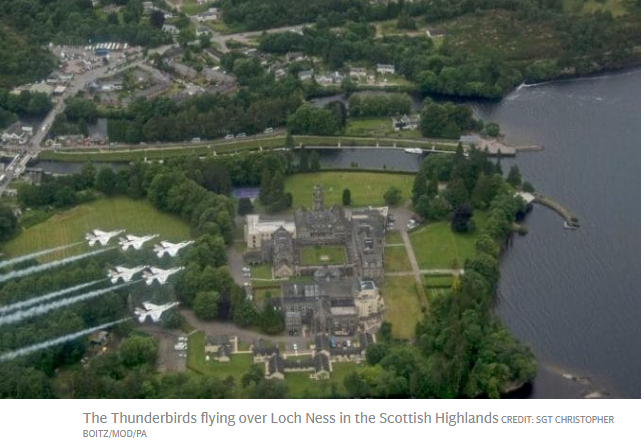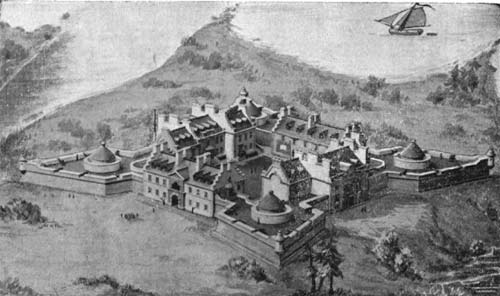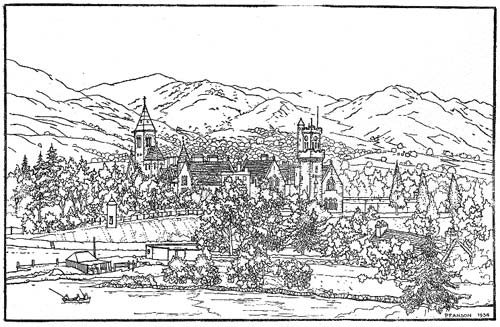The story of this historic site goes further back than the start of monastical life in the Highlands. It is often turbulent, and yet exciting to hear and is also a far cry from the holiday complex it is today.
Each movement of the Abbey’s ownership has its own story to tell, yet they all connect to its origins as a fort. It is a story of intrigue,surprise and often tumultuous times. We hope that now the Highland Club brings a happy ending to a tale of a 200 year old building.
To find out how The Highland Club evolved from an English stronghold in The Highlands, read on.



The Fort
The year 1729 saw the construction of the Fort in the Highland village of Kilchuimen, while the Jacobites, followers of King James VII, grew in strength and numbers. Hence, their belief was that James was the rightful king of Scotland, England and Wales.
So, it was now time for the English to regain control of the Highlands. General Wade was charged with the construction of the Fort, strategically placed at the foot of Loch Ness. From here, the General could command the available roads and paths. Since then, “General Wade’s Road” remains in existence today.
Especially relevant, the name, Fort Augustus, came from William Augustus, Duke of Cumberland. He was, notably, youngest son of George II
From the image, you can see the four pointed angles, therefore, giving the occupants views from all angles. Therefore, not being seen while approaching the fort was difficult. However, this would not stop the Jacobites as they were marching towards Culloden.
Consequently, in March 1746, after a 2-day siege, the Fort was no longer held by the 300 British soldiers. During the battle, a shell exploded the powder magazine. As a result, the Jacobites took control of the fort.
Soon after, The Battle of Culloden saw the end of the Jacobite rebellion at the hands of the Duke of Cumberland. The Fort, therefore held again by the British, could now see a restoration of its original strength and more.
The garrison held the fort for over 100 years. “General Wades Road” (still in existence today) was a connection between the Fort and Fort George, near Inverness. This would, therefore, add to the strength of the garrison’s control.
To see how the Fort became an Abbey, read on.
In 1876, The Lovat Estate were by now, the owners of the fort for the price of £5000 to the Government. It sat with very little use for a period of time. The St Benedictine monks were in search of a site for a monastery. Simon, 13th Baron Lovat, therefore, came to offer the fort by way of donation to the monks.
So in September 1876, the monks made a start on the renovations. Especially relevant is the transformation of the fort from a time of oppression to a time of peace.
Most notable of their work, is the refurbishment of the front section of the fort. Schooling up to 60 students, the Old School’s centre point is the Clock Tower. Standing 110 feet tall, it is a testament to the work of the monks.
A visiting monk once jammed the clock mechanism to stop the chimes which were disrupting his sleep. Father Benedictine woke at 4 a.m, removing the wedge. Consequently, the clock would then chime every quarter hour until it caught up with its correct time, thus awakening the whole Abbey and the villagers.
Also notable is the Monastery Wing, housing 60 monks and facing the foot of Loch Less.
Either side of the Monastery, The Caledonian Canal and the River Tarff empty into the Loch. Within the Monastery Tower was the “Mary Bell”, notably one of the 9 bells of the Abbey. Consequently, these would chime every Sunday and during festivals.
The “Mary Bell” now sits on the eastern stair case of the Monastery and is another awesome sight to behold in the Abbey.
The closure of The Abbey took place in 1988 due to lack of funds and a change in the Scottish Education system. To find out what happened next, read on.



After the Abbey
For a few years, the Abbey was left mostly empty, although a few of the “Old Boys” did remain there. They would oversee some maintenance and general upkeep of the Abbey.
However, in 1993 the Abbey became a heritage exhibition until its eventual closure in 1998.
To find out the next part of the story, read on.
The Highland Club
The Lovat Estate, after seeing the return of the abbey to their ownership, went to sell it to a consortium. This consortium in turn sold the Abbey to The Santon Group. Hence, the dawn of a new era for the Abbey began. The renovations this time would be the creation of luxury apartments and then the addition of the 12 Courtyard Cottages.
As developments were continuing, it was clear the Abbey and its history were more than just newly renovated apartments.
Fort Augustus Abbey celebrated its new name – The Highland Club! And today, it offers luxury accommodation and a range of facilities such as the Club Lounge, tennis court, fitness studio and kids playground.
The Highland Club’s location, at the foot of Loch Ness gives its own dynamic, to a story that spans over 200 years. Additionally, The Highland Club brings its fair share of visitors to Fort Augustus and Loch Ness, many of whom return year after year.
To find out why Loch Ness is so popular, scroll below.


Loch Ness
The Loch stands alone for intrigue, mystery and legend. Primarily sourced from the North Sea, the River Tarff and Thomas Telford’s Caledonian Canal, it is 227 meters deep, and the 2nd deepest loch in Scotland. Some might say, deep enough for a monster to live in…..
Roughly 10000 years old, Loch Ness has a trench like bed, formed by seismic movement over the years. In the last Ice Age, it was an area covered in 4000 feet of ice. Ironically, the vast volume of water, more than all the other lakes in the UK put together, never freezes.
From the bed of the loch, there are many tunnels and caves that give access to the North Sea, the Moray Firth at Inverness and finally the Atlantic Ocean. There are around 40 rivers, streams and burns running into the loch.
About 23 miles long, running from Fort Augustus to Inverness, it holds 263 thousand million cubic feet of water.
The dark tint of the water comes from the peat off the adjacent hills, adding to the mysterious aura of the Loch. Consequently, visibility is low from the surface of the water and even less below it.
To find out why the Loch is so mysterious, read below.
The Loch Ness Monster
Nessie needs no introduction given the world wide fame she has enjoyed over the years since her first sighting in 565 AD.
St Columba’s arrival in Loch Ness for missionary work gave way to him witnessing a fisherman’s injuries after an attack by the monster. This gave rise to the famous monk sending a priest into the water to tempt the monster out. His plan was a partial success as The Loch Ness Monster rose from the Loch. The monk held aloft his cross, banishing the monster from the loch.
Consequently, the monster’s legend grew as did her sightings. Over the years, photographic and film evidence has been under scrutiny by skeptics. But her legend grows and grows with each appearance.
Is she a greenland shark? Is she a plesiosaur? A huge pike? …..a figment of imagination….?
We would not wish to persuade your belief in the Loch Ness Monster, but rather you come visit and see for yourself. Book your accommodation at the Highland Club, and lead your own investigation.




















